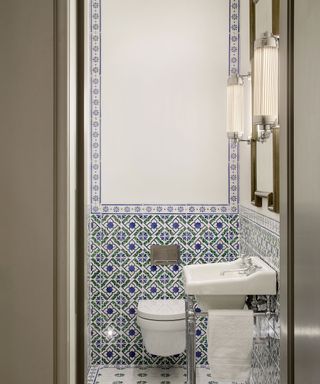These are the most common plumbing mistakes and issues when renovating a house – and how to avoid them
Avoid plumbing disasters during a renovation by following expert advice from professional plumbers


If you’ve ever renovated a house, you will know that plumbing issues are very, very common when renovating. Burst pipes, overflowing toilets, fittings that don’t fit, leaks…The list is seemingly endless. And, given that water damage can be one of the costliest and most difficult problems to fix, you will want to avoid plumbing problems during a renovation. Plumbing mishaps may set your project back weeks or even months, but most of them are preventable.
So, don’t let renovating a house turn into a Mousehunt-style nightmare. Follow this expert advice from professional plumbers before you do anything to your plumbing.
A word on hiring plumbers when renovating
If you think that the plumbing issues we’re about to outline below happen exclusively during DIY renovations, you are mistaken. Plumbing damage occurs all the time during renovations even when the plumbing is being renovated by professionals. Construction and plumbing expert Josh Rudin sees this happen all the time, and it’s almost always because ‘people hire a handyman to fix something, and that “expert” didn’t have the knowledge or capacity to do the job correctly.’
Having a plumbing issue caused by a handyman can have worse consequences than your own mistakes because, as Josh explains, things will look ‘like they are fixed’ only for the homeowner to discover ‘much bigger problems down the road.’ ‘Incorrect pipe sizing, fitting incompatibility, vent stack blocking, cracked piping, and poor glue welding’ - it’s all been done by inexperienced contractors.
Always thoroughly vet plumbers before hiring them to do your renovations. And if hiring a general contractor, make sure the plumbers they work with are licensed and have extensive experience in plumbing specifically. Don’t feel awkward about asking to see the licenses. A good contractor or plumber will never have an issue with that.
Kevin Driscoll, of KJD Architects, is an expert witness for home renovation disputes. He told us that he has personally dealt with a case where ‘the GC (general contractor) claimed that all her subcontractors were licensed, but after the renovation was completed, it turned out they were not, ‘and the homeowner faced having to tear out all of the new drywall so that the plumbing could be inspected by the city.’ Don’t let that be you!
The most common plumbing issues when renovating a house

1. Not replacing old plumbing
It can be tempting to just not do anything at all to the plumbing while remodeling a bathroom when it seems fine. Unfortunately, the ‘let it be’ approach is often a bad one. Hendrik Vandepoll, Co-owner and Field Manager at Service Force Plumbing, is empathic that ‘depending on the age of your home, you should be ready to replace plumbing that is old and at a high risk of failing in the relatively near future.’
Not doing so could cause your bathroom renovation costs to spiral. For Vandepoll, ‘it is always heartbreaking to get a plumbing call for a significant leak and arrive to discover a recently remodeled space that has to be completely torn apart to replace an old, galvanized water pipe or copper pipe that could have been replaced when everything was opened up, rather than tearing up drywall or new flooring that cost thousands of dollars to put in.’
If you’re doing the bathroom renovation yourself but are unable to detect potential problems with your old plumbing, it’s a good idea to consult a professional. A respectable plumber will not offer to replace something that doesn’t need to be replaced, but they could save you the anguish and enormous expense of having to redo everything.

Hendrik is a 32-year Master Plumber and co-owner of Service Force Plumbing, based in Rockville, Maryland.

2. Accidental damage to existing pipes
Jay Sanders, a licensed contractor and the owner of Maryland Contractors, based in Baltimore, MD says that damage to pipes ‘usually happens due to the drilling or knocking down walls without actually knowing what is behind them.’
Fortunately, there’s a very simple preventive measure for this issue – using a pipe detector before any demolition work. Jay recommends investing in ‘a quality pipe detector.’ It will cost you anywhere between $50-200, but ‘in the long run, it can save you thousands in potential damage.’
While improper drilling and wall knockdowns are the primary reasons for pipe damage, sometimes pipes are damaged in less dramatic ways. For example, Josh Rudin has seen pipes damaged by the renovator ‘dropping tools on them.’ The result can be a small and unnoticeable crack; however, over time, ‘When cracks go unnoticed, the water being transported through them can cause the crack to become a source of contamination.’
If the crack is bad enough, it ‘can and will lead to a rupture when more pressure is put on the system. This can become a major water damage catastrophe if not addressed promptly, warns Josh.
Because of the potentially serious consequences, replacement pipes should never be left lying around the bathroom while other work is being done. Make sure that all pipes are safely stored away until they are ready to be installed.

Joshua Rudin is the Owner of ASAP Restoration, LLC and a Certified Restorer.
3. Incorrect pipe sizing
This is another plumbing issue that is very common during renovations. Jay says that ‘most people are not aware of the fact that water pressure is usually reduced by using pipes that are too small.’ And the problems from an incorrectly sized pipe won’t stop at low water pressure in your shower. As Josh Rudin also points out, incorrectly sized pipes can cause far worse problems down the line, including ‘backups, clogs, and slow drainage that can ultimately cause major water damage issues down the road.’
Some pipes, especially PVC, CPVC, or PEX, have the size labeled directly on them. For unlabeled pipes, ‘you will need to measure the outside diameter and consult a conversion chart to find the corresponding nominal pipe size’, Jay explains.
4. Not replacing the toilet flange when changing floor heights
Bathroom renovations often result in changes to the floor height. This happens typically because the new bathroom floor tile is thicker or thinner than the old one. While this generally isn’t an issue, it can be when the home renovator does not install a new toilet flange to sit flush on the new floor. As Roy Barnes, Co-owner and Service Manager of Service Force Plumbing, explains, ‘when this happens, the wax ring that seals the toilet to sewer pipe connection does not fit properly. So you either end up with a seal that is not tight enough, or the installer squeezes two wax rings into the space to try to fill it and create a tight seal.’
Eventually, ‘after a year or two or ten, that wax ring starts to leak, and maybe the homeowner notices it due to visible water or a sewer smell, or worse, they don’t notice it and it rots out their subfloor and joists, which is a very expensive repair.’
So, always make sure that the new toilet flange sits flush with the floor. It seems like a small thing, but it can become a much bigger issue further down the line.
5. Installing incompatible fittings
This is a very common scenario: you forgot you needed x part; you quickly ran to the hardware store, only to realize that you’d forgotten the exact type/size of part you needed. You grab the one that seems like it will – and, voila, it does fit when you get home and try to put things together. Lucky you, right?
Sadly, often this ‘if it fits it fits’ approach can lead to plumbing issues further down the line. Josh explains that ‘fittings that seem like they lock together aren’t always compatible with one another, and if these aren’t checked and tested for leaks before everything is sealed back up, then they can be a major source of water damage, flooding, and mold contamination.’
Before sealing up your new plumbing, turn the water on and check very carefully for even small drips from any of the replaced fixtures. If there’s any water whatsoever, your fixtures don’t fit right.
6. Buying off-brand fixtures
Bathroom renovations can be expensive, so it’s tempting to get off-brand bathroom fixtures from a big online retailer and save yourself a couple of hundred. This is a big mistake, according to Roy Barnes, who cautions that although off-brand fixtures ‘may look great, it can be impossible to find parts for them. Unfortunately, we get calls all the time from people whose valves are not shutting off or are leaking, but there are no replacement cartridges available.’ At that point, ‘the only solution is to break up all that nice tile they had installed for their new renovation, completely remove the old fixture, and install a new one.’
Yes, branded plumbing fixtures are expensive, but they also come with a guarantee of replacement parts in case something fails.
7. Installing gate shut-off valves
The shut-off valves on your plumbing are essential. If there is a plumbing emergency, you want to be able to shut off those valves as fast as possible. For that reason, Hendrik Vandepoll advises against installing turn-turn-turn gate valves as these can ‘the gate can get clogged with debris or scale over time. As things get older, you may be unable to close the gate valve fully, probably just at the moment that there is a problem with the fixture, and you really, really need to shut it off.’
The solution? Always use ¼ turn ball valves: ‘The ball valve mechanism is actually protected from debris and scale’, which means they won’t let you down when you need to use them.

FAQs
How can you prevent plumbing problems when renovating?
As you can see, most of the plumbing issues during renovations happen due to either carelessness or excessive cost-cutting. Hiring an experienced plumber for the job and budgeting appropriately will solve most of these issues.
Andy Hochberger, General Contractor at Impact Home Remodeling, has the following parting advice for homeowners: ‘Be ready for some surprises’ that ‘weren’t in the proposal price.’ That old or cracked pipe truly needs to be replaced to prevent a major plumbing disaster further down the line. You may end up paying extra during the renovation, but you’ll save yourself trouble further down the line.
Sign up to the Homes & Gardens newsletter
Design expertise in your inbox – from inspiring decorating ideas and beautiful celebrity homes to practical gardening advice and shopping round-ups.

Anna is a professional writer and academic. She taught English Literature for several years before joining Future where she wrote for Real Homes, Homes & Gardens and Livingetc for four years. She is a regular contributor for Parade Home, BiggerPockets, and many other publications. In her spare time, Anna enjoys hiking and gardening.
-
 Apparently, this is the interior design style that will add the most value to your home right now
Apparently, this is the interior design style that will add the most value to your home right nowAll hail the modern organic style as a recent Zillow survey says homes with natural features and organic surfaces sell for more
By Eleanor Richardson Published
-
 7 low-maintenance backyard ideas for maximum impact with minimal effort
7 low-maintenance backyard ideas for maximum impact with minimal effortReduce the toil and create a beautiful outside space that you can relax in and enjoy throughout the seasons, with these simple ideas from gardening professionals
By Jacky Parker Published